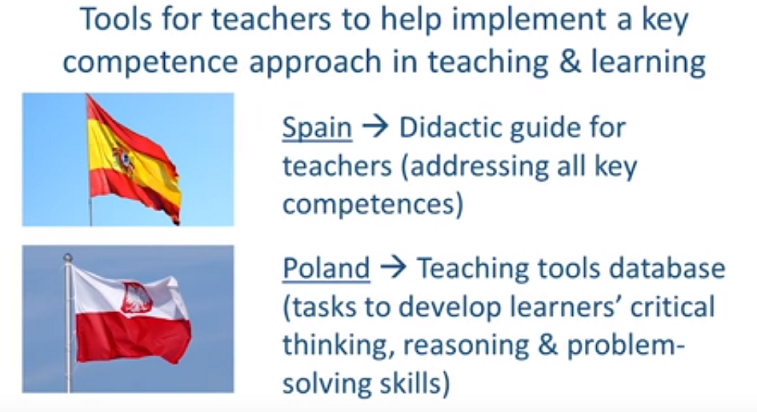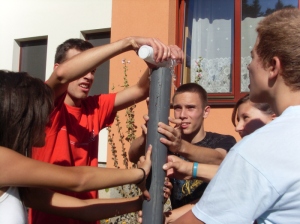The key competence approach, with its emphasis on the application of knowledge in real world situations represents a significant departure from traditional content-based approaches where subjects are taught and assessed discretely. The main recommended approach to teaching key competences is through the provision of interactive learning environments in which learners can engage in practical, inquiry-based tasks. These environments present open-ended problems and challenges to be solved through debate, experimentation, exploration and creativity.
WHY ARE INTERACTIVE LEARNING ENVIRONMENTS SO IMPORTANT?
Simulating real world contexts has three main purposes:
– it can motivate learners more than traditional approaches,
– learners are more likely to remember concepts
– they discover on their own,
– it provides a meaningful context for problem-based learning

Key Points on Assessing Key Competences
As there is a new approach to teaching teachers need to develop new approaches to assessment.
These include:
- Summative assessment – that is the tests and examinations they design in order to assign course grades, or at the end of the school year.
- Formative assessment – the kind of interactive assessment that takes place in the course of learning, where the information gathered can be used to adjust teaching and learning and better meet student needs.
- And student self-assessment of progress toward the transversal competences. These are competences that do not have a learning “standard” – such as creativity, initiative and constructive management of feelings – but where it may be important for each student to track his or her development.
Key competence approach in school education varies in different countries in Europe
No country has made a complete shift to competence-based education, several countries have made significant progress. In addition to introducing legal and curricular frameworks for key competences, countries have used various strategies to foster a competence-based approach in the classroom. These include innovative partnerships, pilot projects, the monitoring and evaluation of new initiatives, dedicated funding and capacity building.
These are examples of Spain and Poland:

What do stakeholders think about key competences in education?
The important fact is that stakeholders agree that key competences of XXI century education are important and should be implemented.

Survey also shows that more and more teachers and head teachers are aware of what key competences are:

Module 1 Learning Activity:
Self-assess Your
Key Competence Approach!
SECTION A: YOUR SELF-ASSESSMENT
DESCRIPTION: This first learning activity is a self-assessment exercise. We would like you to reflect on how aligned your current teaching and assessment methods are with the key competence approach.
OBJECTIVE: The objective of this learning activity is for you to better understand to what extent your teaching already involves a key competence approach, and in which areas you would like to make progress. Remember to take the time to reflect properly and to be honest with yourself. Assessing your starting point truthfully will help you make progress in modules 2 and 3 of this course, and enable you to improve your practice.
DEADLINE: Please complete and submit this template on the Teacher Academy platform by Sunday, 25 September, 23:59 CEST. It is preferable for you to complete this learning activity by this date, as it will help you benefit more from Modules 2 and 3 of this course. However, should you not have time, or join the course at a later stage, you can submit your learning activity until Sunday, 9 October, 23:59 CEST.
SUBMISSION: To complete this learning activity you need to fill in this template and submit it, by clicking on the ‘hand-in task’ button in the ‘Learning Activity’ area.
TASK:
1a) To what extent does your teaching and assessment of learners currently involve the 10 key principles associated to the key competence approach? To refresh your memory of what each one entails, watch video 1.3.2 where the first 8 key principles about teaching are described, and video 1.3.3 where the final two principles about assessment are described. Next to each of the key principles in the box below insert one ‘X’ in the relevant column to indicate to what extent it is present in your teaching:
| KEY PRINCIPLE
|
Not at all present | Weakly present | To some extent present | Strongly present |
| 1. Task-based
|
x | |||
| 2. Interdisciplinary
|
x | |||
| 3. Collaborative and individualized
|
x | |||
| 4. Learner- and teacher-led
|
x | |||
| 5. Technologically innovative
|
x | |||
| 6. Take place both inside and outside of school
|
x | |||
| 7. Involve collaboration with the wider community
|
x | |||
| 8. Pay attention to the social and emotional aspects of learning
|
x | |||
| 9. Classroom-based formative assessment
|
x | |||
| 10. Student self-assessment of transversal skills
|
x |
1b) Use the box below to explain in more detail any of the options you selected above. For example, if for key principle number 3 you opted for ‘to some extent’, explain whether this is because most of your teaching is teacher led and only sometimes learner-led, or vice-versa. You may also want to use this space to reflect on the factors which have prevented you from fully implementing these principles in your practice (OPTIONAL)
|
Task-based – I try to give students some more complicated problems to solve and present Interdisiplinary – some of the tasks involve their knowledge of other subjects on which they have to base to prepare their projects Collaborative and individual – I very often ask students to work collaboratively but leave them freedom to individualized their final work, and also sometimes I give students possibility to undertake individual tasks – they can choose their own subjects and ideas Learner-and-teacher led – I have to admit that I rarely allow them to lead lessons Technologically innovative – I very often ask them to create some works using new technology We rarely work outside school And I rarely involve wider community I hope I try to create activities that involve social and emotional aspects of learning I have to admit that assessment is the principle I have to work most as it is with collaboration with wider community
|
2) Choose one or more of the key principles which you selected above as being strongly or to some extent present in your teaching, and provide evidence of this. The evidence you provide can take a variety of forms. Some examples are provided below (the list is not exhaustive):
- A simple written description of a few lines explaining how you currently are implementing or have implemented this principle in your teaching.
- A lesson plan illustrating one or more of the principles in action
- A link to a video showing classroom practice where some of the key principles are evident
- A link to a presentation describing a project you did with students which involved some of these principles
- Students’ work
- A class/school blog or website
In the box below mention the principle you are providing evidence for, and insert your evidence (e.g. a short description, or a link to a video or presentation).
https://teensculturalexchange.wordpress.com/category/weather/
|





